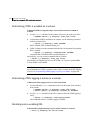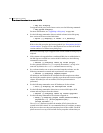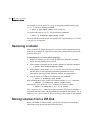
283Administering volumes
Adding a RAID-5 log
Adding a RAID-5 log
Note: You need a full license to use this feature.
Only one RAID-5 plex can exist per RAID-5 volume. Any additional plexes
become RAID-5 log plexes, which are used to log information about data and
parity being written to the volume. When a RAID-5 volume is created using the
vxassist command, a log plex is created for that volume by default.
To add a RAID-5 log to an existing volume, use the following command:
# vxassist [-b] [-g diskgroup] addlog volume [loglen=length]
Note: If specified, the -b option makes adding the new log a background task.
You can specify the log length used when adding the first log to a volume. Any
logs that you add subsequently are configured with the same length as the
existing log.
For example, to create a log for the RAID-5 volume volraid, in the disk group,
mydg, use the following command:
# vxassist -g mydg addlog volraid
Adding a RAID-5 log using vxplex
As an alternative to using vxassist, you can add a RAID-5 log using the vxplex
command. For example, to attach a RAID-5 log plex, r5log, to a RAID-5 volume,
r5vol, in the disk group, mydg, use the following command:
# vxplex -g mydg att r5vol r5log
The attach operation can only proceed if the size of the new log is large enough
to hold all of the data on the stripe. If the RAID-5 volume already contains logs,
the new log length is the minimum of each individual log length. This is because
the new log is a mirror of the old logs.
If the RAID-5 volume is not enabled, the new log is marked as BADLOG and is
enabled when the volume is started. However, the contents of the log are
ignored.
If the RAID-5 volume is enabled and has other enabled RAID-5 logs, the new
log’s contents are synchronized with the other logs.
If the RAID-5 volume currently has no enabled logs, the new log is zeroed before
it is enabled.


















